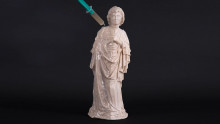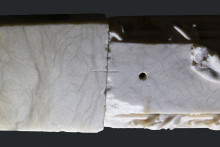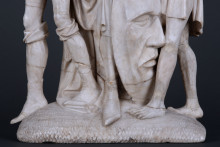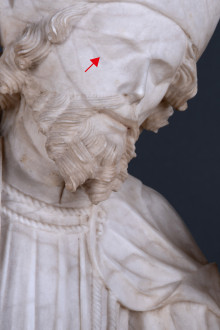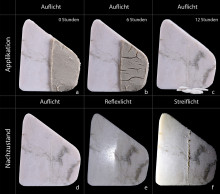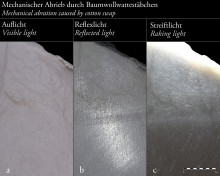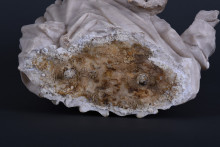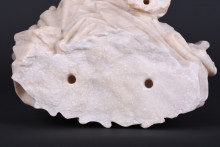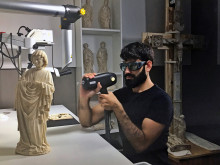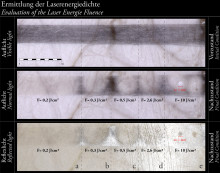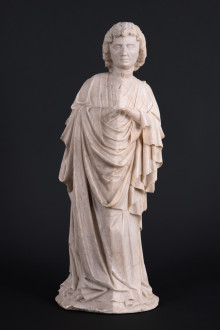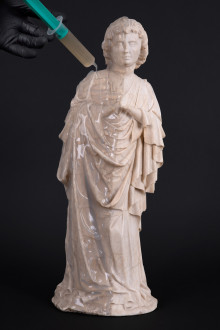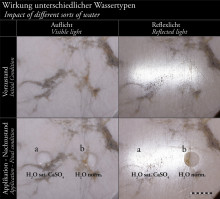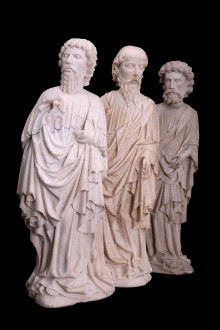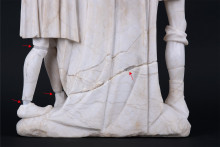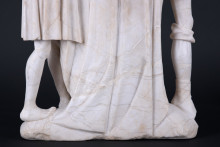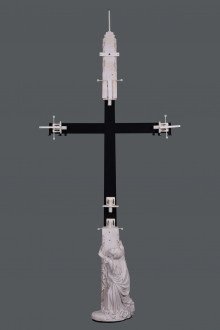Publication
Learn more in the exhibition publication. Available in our online shop.
The reasons why restorative action on the Rimini Altarpiece was necessary were obvious at the beginning of the project: Above all, the additions made of fracture-prone modelling plaster to the central cross in the early 1970s caused enormous conservation problems, which endangered the adjacent pressure-sensitive original substance.
In addition, art-technological findings revealed that these proportion-extending additions were not originally present (figs. 1 a–c). A complete removal of these later additions was therefore deemed appropriate. The same applied to the fracture mends, which had become brittle and unsightly yellowed over time. Several had already opened or threatened to do so in the future in an uncontrolled manner. A safe presentation of the object had become impossible at this point.
Although the existing surface contamination was not urgent from a conservation point of view, it was an enormous aesthetic disturbance. The grey-yellowish film of dirt, as well as the stained bonding agents and glue residues distributed on the object, largely covered the fine, bright-white material effect of the alabaster and gave the piece an unkempt appearance (fig. 2). The aim of the planned cleaning was to restore an even material effect to the stone, allowing undisturbed legibility of the play of light and shadow on the sculptural masterpiece.
Conservation video
The video on the conservation gives further insight into the work process.
The top priority for all the measures carried out was to avoid once again stressing or damaging the substance, which had already suffered severely due to earlier interventions. This was not an easy challenge, considering that the material properties of alabaster make it one of the most vulnerable and problematic types of stone in terms of conservation and restoration. The visible damage caused by later interventions on most of the alabaster sculptures preserved today reveal that the sensitivity of the material was probably only sporadically recognised or taken into account in past epochs (fig. 3). In order to be able to assess the possibilities and limits of the restorative treatment of alabaster as objectively as possible and to be able to learn from the damaging treatments of the past, elaborate series of tests on historical and currently common restoration methods were carried out on alabaster sample stone from the Rimini alabaster quarrying area in the run-up to the restoration (fig. 4).
The test series revealed that alabaster is much more sensitive to mechanical impact than was often assumed until now (fig. 5). When removing the old bonding agents, adhesives, and reinforcements, this had to be particularly taken into account. Adhesives were therefore dissolved exclusively in solvent vapour and removed from the surface with absorbent cellulose compresses.
Larger additions were first destabilised by saw-cuts and drillings, and then the flat portion of the material was carefully reduced by cutting or scraping. The last layer of the auxiliary material, however, lying directly on the sensitive alabaster surface, could only be removed with a scalpel under strong microscopic magnification and with the utmost care—comparable to the removing of overpaintings. All aged and brittle bonding agents were also removed in the same way (figs. 6a, 6b).
Freed from adhesives, bonding agents, and additions, the surface of the sculptures was now ready to be cleaned. Although traditional cleaning methods generally show resounding results, the tests we carried out on alabaster specimens have shown that hardly any of these current methods can be applied without damaging the alabaster. Therefore, the methods we found most suitable—laser cleaning and cleaning with agar compresses—were tested and, where necessary, refined or combined until a gentle method could be determined that allowed us to remove dirt without further damaging or altering the delicate stone.
In the cleaning of alabaster, laser treatment shows decisive advantages over conventional methods (fig. 7). For example, the problematic use of water can be avoided with this method.
Likewise, the action of the laser does not involve any mechanical impact. On the basis of test series carried out, a tolerance range of the ‘Rimini alabaster’ could be determined toward an Nd:Yag laser with 1064 nm wavelength. This means that within a certain energy range and exposure time, the laser reacts only with the dirt particles, but not with the alabaster itself (figs. 8a, 8b).
However, the selective reactivity of the laser not only affects the alabaster, but also some dirt particles. Similar to the alabaster, these do not react with the laser and remain on the surface in the form of a yellowish veil. This so-called yellowing effect is therefore not, as has often been claimed thus far, a change in the material of the alabaster (fig. 9). This slightly remaining yellowish veil of dirt can be further reduced relatively easily with another method, namely the agar gel compress made with specially prepared water.
The agar-agar powder derived from red algae can be dissolved in hot water and forms a solid gel when cooled below 40 °C. This hardly noticeably releases the water bound in it. This is why the gel compresses made from it are often used in restoration work where wet cleaning of water-sensitive surfaces is unavoidable. Another advantage of agar gel is that it is able to absorb fine dirt particles. Warm to the touch, the agar-water solution is still sufficiently flowable to be applied directly to the object via a syringe. There, it adapts to even the finest surface structures and then forms a solid gel within a few seconds (fig. 10). This has no adhesive power, so that, when applied properly, it does not adhere to the alabaster. After the desired exposure time, it can be removed from the object without leaving any basic residue. To prevent the stone from dissolving, the water used to prepare the gel was previously saturated with calcium sulphate—the material alabaster is composed of (fig. 11).
The best cleaning results were achieved by combining the two methods simultaneously: That is to say, the laser cleaning was carried out through the transparent agar gel compress. The dirt was reduced to such an extent that the actual material effect of the alabaster reappeared (fig. 12).
The adhesion and bonding of the fractures was carried out with reversible, alabaster-compatible materials that have long since proven themselves in restoration (figs. 13 a–d).
Unlike before, a special support system was developed for the presentation of the crosses, which makes a rigid connection of the individual object segments unnecessary and prevents them from weighing on each other (fig. 14).
The insights gained from over four years of conservation were part of the exhibition “THE RIMINI MISSION. Material, History, Conservation” and formed the basis for the accompanying publication, which summarizes the results of several years of research, supplemented by art historical contributions. It is the first monograph on the Rimini Altarpiece.
Photos: © Liebieghaus Skulpturensammlung, Frankfurt am Main



